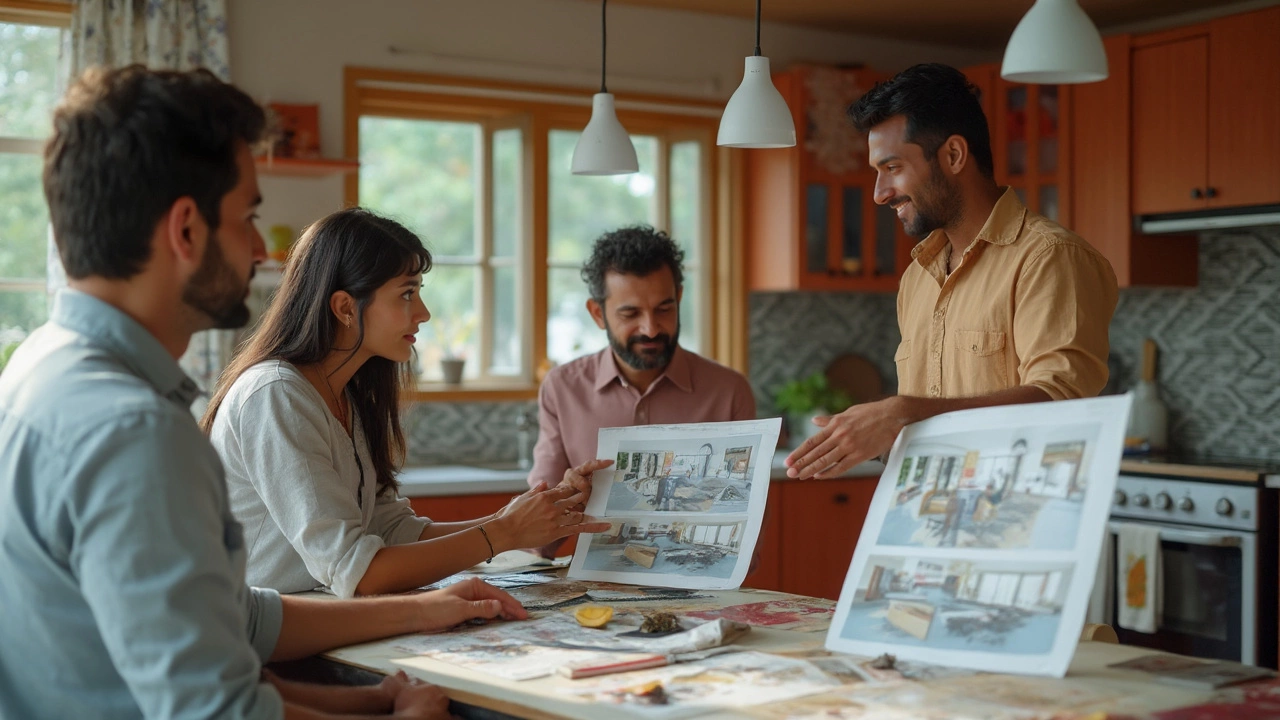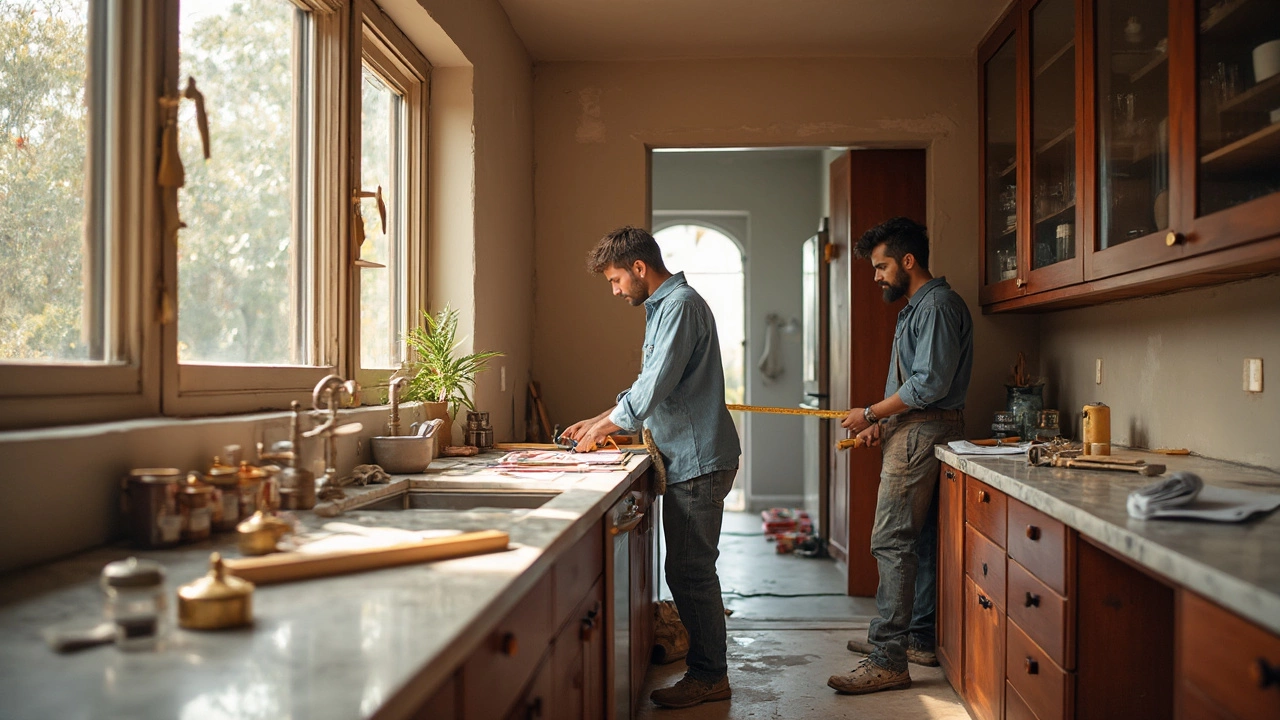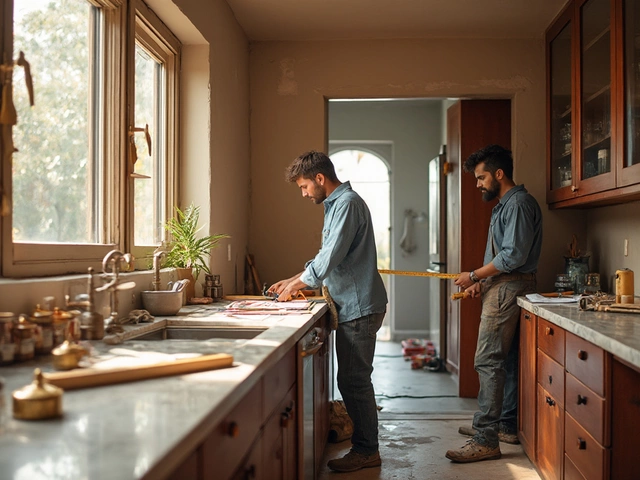Most people think kitchen installation is just about putting in new cabinets and worktops, but it goes way deeper than that. The real magic starts before the first screw goes in, with careful planning and measuring. Miss a detail here, and you can end up with awkward gaps, doors that bang into walls, or worse—appliances that don't fit.
There’s a lot going on behind the scenes too—removal of the old units, new plumbing, and electrical rewiring. If you ever wondered why installers always have a toolkit that looks like it could fix a rocket ship, this is why. Modern kitchens almost always mean rerouting pipes or adding extra outlets for all those gadgets we’ve come to rely on.
Want things to run smooth? Get all your measurements sorted and check your appliances before anyone starts swinging a hammer. Bring a notepad, jot down things that worry you, and don’t be afraid to double-check what’s being installed where. Trust me, it saves a lot of headache later on.
- Pre-Installation Planning
- Removing the Old Kitchen
- Plumbing and Electrical Work
- Fitting Cabinets and Worktops
- Installing Appliances
- Final Checks and Clever Finishing Touches
Pre-Installation Planning
Jumping straight to new cabinets or appliances skips the most crucial bit: planning. A proper kitchen installation can’t begin until you nail down the layout, design, and what fits in your space. The planning stage is where you avoid expensive mistakes and find out what’s actually possible in your kitchen—no matter how many amazing ideas you’ve pinned online.
First up, measure everything. I’m talking walls, windows, doorways, ceiling heights—the works. Professionals use laser tools for this because being off by even 1 cm can throw everything else out of sync. Next comes design drawings. Most installers or kitchen companies will offer — or even require — a detailed floor plan and elevation drawings.
If you fail to plan, you are planning to fail." – Benjamin Franklin
Don't forget your kitchen installation isn’t just about pretty cabinets. You need to plan plumbing points for sinks and dishwashers, dedicated electrical circuits for ovens, and the right ventilation. Most folks get surprised by building regulations or limits in older homes. Ask your installer if you need permits or special approvals, or you could face major delays.
- Check appliance specs before finalizing cabinet sizes – fridges, ovens, and dishwashers all need room to breathe, literally for ventilation.
- Leave enough power outlets and lighting plans. Under-cabinet lighting can be a game-changer but needs to be noted at this stage.
- Set aside a little extra budget for unexpected hiccups, like hidden pipes or outdated wiring.
| Task | Typical Time Required |
|---|---|
| Measuring & site survey | 2-3 hours |
| Design and planning approval | 1-2 weeks |
| Ordering appliances & materials | 2-8 weeks (depends on manufacturer) |
The prep work may feel dull, but the more decisions and research you do now, the easier your kitchen installation goes later. Keep an open dialogue with your installer—don’t assume they know what you want unless you say it or write it on the plans.
Removing the Old Kitchen
Tearing out your old kitchen is more complicated than just grabbing a crowbar and going to town. Good kitchen installation teams follow a checklist, making sure nothing gets missed and the worksite stays safe. First, they shut off water, gas, and power to avoid leaks, shocks, or any kitchen-disaster stories. A lot of people think they can skip this, but trust me—nobody wants a surprise water fountain when removing that ancient dishwasher.
Once the utilities are off, the real work begins:
- All cabinets get unscrewed and carefully pried off the walls.
- Worktops are removed, sometimes needing two people for heavy lumps of stone or wood.
- Old appliances like ovens and fridges are disconnected and taken out. Good installers will even handle responsible disposal or recycling of these, which not everyone knows is a legal requirement in some areas.
- Tiles, splashbacks, and flooring might need removing depending on your new layout. This brings the space back to square one, ready for whatever comes next.
It’s pretty common to find hidden issues—like water damage behind the sink or dodgy wiring stuffed in a corner. Over 40% of kitchen installers say they run into surprises once cabinets come off. If you’re managing this part yourself, have a contingency plan or a friendly tradesperson on-call.
Don’t forget about cleanup. Professional teams will leave the area tidy and safe for the next phase. If you're doing the demolition alone, rent a skip and keep dust sheets handy. Honestly, a little prep goes a long way in making your kitchen installation project less of a headache.
Plumbing and Electrical Work
If you only remember one thing about kitchen installation, make it this: plumbing and electrical work are not optional. They’re the guts behind every modern kitchen. You can have the best cabinets and counters in the world, but if your sink can’t drain or your oven can’t turn on, it’s all pointless.
First up, let’s talk plumbing. For most kitchens, that means connecting the sink, dishwasher, and sometimes fridges with built-in water dispensers or ice makers. Good installers always check pipe locations before anything else—even one centimeter off can make fitting a cabinet impossible. Re-routing water lines or adding isolation valves is common, especially in older homes where nothing is standard.
On the electrical side, new kitchens almost always need more outlets. Microwaves, toasters, blenders—the average kitchen now has way more plug-in gadgets than twenty years ago. Installers usually:
- Upgrade the circuit for bigger appliances—ovens and hobs usually need their own separate, heavy-duty line.
- Add sockets above the counter for daily-use appliances.
- Install under-cabinet lighting or add switches for extractor fans.
Every country (and even some cities) have strict rules about who can do plumbing and electrical work. For example, in the UK, you need a certified electrician for most new kitchen wiring. Cutting corners here is risky; insurance won’t cover water damage or electrical fires caused by dodgy work.
Here’s a quick look at what’s usually needed during kitchen installation:
| Task | Who Does It? | Why It Matters |
|---|---|---|
| Water pipe installation | Plumber | Ensures the sink and appliances get clean water with no leaks. |
| Waste pipes and traps | Plumber | Prevents clogs and foul odors from entering your kitchen. |
| Electrical outlet installation | Electrician | Powers up your appliances safely. |
| Lighting circuit setup | Electrician | Lets you see what you’re doing, day and night. |
Before work starts, make a list of every appliance you want. Ever tried fitting an American-style fridge in a space designed for a tiny British one? Trust me—it’s a mess when you realize your water connection is on the wrong wall. So always make a plan, talk with your installer, and sort your plumbing and electrical work upfront. Saves a ton of headaches later.

Fitting Cabinets and Worktops
Fitting your cabinets and worktops is where your kitchen installation takes real shape. Installers always start with the base units, making sure everything is level. If the floor's not flat (which is super common in older homes), they have to adjust the legs or add shims. If they skip this, your worktops and drawers might look crooked. Wall cabinets go up next—usually at least 450mm above your worktops, so there’s enough space for kettles, plugs, and even your favorite stack of mugs.
One fun fact: The average gap between cabinet doors for UK-standard kitchens is just 2mm. It sounds tiny, but that’s what keeps everything looking crisp and premium. Most fitters use laser levels these days to get it bang-on, but they’ll still double-check by eye too.
Once cabinets are solid, it’s time for the worktops. Heavy stone worktops like granite or quartz need a proper template made before cutting, to avoid expensive mistakes. If you’re going with laminate, these can be trimmed and fitted on-site a lot faster. For both, installers use special sealants at the joins to stop water sneaking in underneath—nobody wants a warped chipboard in year two.
Curious about what goes where? Here’s a quick rundown of what the pros do when fitting cabinets and worktops:
- Mark out cabinet locations with chalk or tape before fixing anything
- Check walls for pipes or wires—sometimes you have to notch out spaces at the back of units
- Fix cabinets starting from a corner and work outwards for a neat finish
- Use joining bolts to connect cabinets, which keeps lines tidy
- Test-fit all appliances like ovens and dishwashers to make sure gaps are just right
- Secure worktops with hidden brackets and strong adhesives
- Seal around sinks and wall joins to keep water out
Most teams can fit basic cabinets and laminate tops in two days, but it can be three or more if you’re going full custom or using stone. If you want lighting under cabinets, fitters often run the wires or prep the space now, before the final fix. Want everything aligned? Open every door and drawer while the team’s there so you can flag anything off-kilter before they leave.
| Installation Step | Typical Time Needed |
|---|---|
| Base Units | 5-8 hours |
| Wall Cabinets | 2-4 hours |
| Laminate Worktop | 2-3 hours |
| Stone Worktop | Requires 5-7 day templating and custom fitting |
Details like soft-close hinges, handle placement, and edge finish are all sorted in this stage. If you spot puffed-up paint or see daylight through joins, speak up—these are things the installer should fix before moving on. Don’t let “it’ll settle later” be the final word if something feels off!
Installing Appliances
When it comes to kitchen installation, appliances aren’t just dropped in and plugged up. Each one comes with its own set of instructions, fitting quirks, and connection requirements. And you really don’t want your oven tripping the breakers or your new fridge scratching your fresh floor.
Here’s what actually goes into installing kitchen appliances the right way:
- Positioning: Oddly enough, where you put your appliances makes a huge difference. Fridges need enough space at the back for ventilation, dishwashers want to be near plumbing, and ovens should never go next to the fridge.
- Connections: Most appliances are “ready to plug and play,” but ovens, hobs, and dishwashers often need hardwiring or plumbing. A pro installer checks if you’ve got the right sockets, switches, and pipework in place before hooking anything up.
- Levelling: No one wants a wobbly washing machine or oven. Installers use spirit levels to make sure things are flat so doors shut right and there’s no annoying rattling.
- Testing: This is surprisingly important. After fitting, installers will usually run a quick test cycle or power up the appliance to spot leaks, missed wires, or basic faults. Catches these now, and you save loads of hassle later.
You’ve probably heard horror stories about water leaks or dodgy wiring. The reality is, fitting a dishwasher often means working under the sink with tight pipes, and installing a hob needs a certified electrician if it’s gas or hard-wired electric. Not every installer can handle every task—sometimes they’ll call in plumbers or electricians for the heavy stuff.
| Appliance | Specialist Needed? | Common Issues |
|---|---|---|
| Oven (Electric) | Electrician | Amperage mismatch, wiring errors |
| Oven (Gas) | Gas Safe Engineer | Leaky connections, ventilation issues |
| Dishwasher | Plumber | Leaks, drainage setup |
| Fridge Freezer | No (usually) | Tight spaces, proper levelling |
| Washing Machine | Plumber | Hose connections, balancing |
Pro tip: Save all the manuals and warranty cards the moment things come out of the box. They’re handy when stuff goes wrong—plus, most brands want proof you didn’t do any DIY damage before helping out with repairs.
Final Checks and Clever Finishing Touches
This is the make-or-break moment for any kitchen installation. You’ve already spent days (maybe weeks) watching the dust settle and tools fly. Now, before you sign off, it pays to slow down and triple-check everything. A lot of small details get missed in the rush to finish, but these details can drive you nuts later on.
Start with the doors and drawers. Do they all line up and open smoothly? Nothing’s worse than a cabinet that sticks or scrapes right after install. Next, check all handles and knobs for tightness; these loosen faster than you’d expect, especially if you cook a lot.
When it comes to appliance connection, verify that everything works. This means powering on ovens, running a cycle on the dishwasher, and making sure the fridge is cooling. If your installer handles plumbing, run the taps and look for leaks under the sink. Even a slow drip can do damage over a few weeks.
- Switch on every light and outlet. Even one missed socket can be super annoying later.
- Run your hand along all worktop edges—feel for rough spots or unfinished edges.
- If you’ve got under-cabinet lighting, try dimming and brightening to check for flickers.
- Test all soft-close hinges or drawer runners—these are a big selling point in modern kitchens, but sometimes installers miss a faulty one.
Finishing touches are what really make the space feel yours. Think about silicone sealing between worktops and walls, or making sure kickboards are flush against the floor. Ask about protective covers for corners if you’re accident-prone like me. Some installers even offer to fit organizers inside cabinets or run a bead of grout around tiled splashbacks for a neater look.
Want to see a common punch-list? Here’s a simple table that covers things most people forget:
| Task | Why It Matters |
|---|---|
| Check all door hinges and drawer slides | Prevents future wobbles and sticking |
| Test all electric and plumbing fixtures | Catches leaks or dead sockets early |
| Inspect silicone seals | Stops water damage on surfaces |
| Clean up debris and dust | Makes the kitchen ready for use |
| Ensure appliances work as intended | Avoids awkward breakdowns after installer leaves |
Don’t forget to keep a copy of your installer’s contact info. Sometimes, an issue pops up a week later—a good installer should come back and sort any problems covered by their installation guarantee. I made the mistake of tossing an invoice once, and trust me, hunting down a company after the fact is a headache you don’t need.






